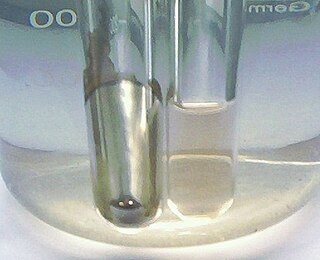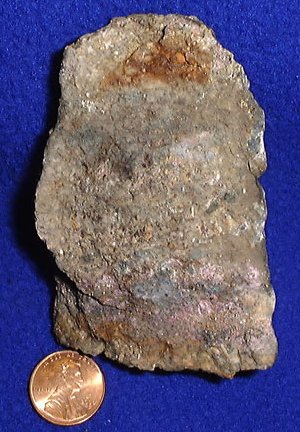Detecting cations
According to their properties, cations are usually classified into six groups. [1] Each group has a common reagent which can be used to separate them from the solution. To obtain meaningful results, the separation must be done in the sequence specified below, as some ions of an earlier group may also react with the reagent of a later group, causing ambiguity as to which ions are present. This happens because cationic analysis is based on the solubility products of the ions. As the cation gains its optimum concentration needed for precipitation it precipitates and hence allowing us to detect it. The division and precise details of separating into groups vary slightly from one source to another; given below is one of the commonly used schemes.
1st analytical group of cations
The 1st analytical group of cations consists of ions which form insoluble chlorides. As such, the group reagent to separate them is hydrochloric acid, usually used at a concentration of 1–2 M. Concentrated HCl must not be used, because it forms a soluble complex ([PbCl4]2−) with Pb2+. Consequently, the Pb2+ ion would go undetected.
The most important cations in the 1st group are Ag+, Hg2+
2, and Pb2+. The chlorides of these elements cannot be distinguished from each other by their colour - they are all white solid compounds. PbCl2 is soluble in hot water, and can therefore be differentiated easily. Ammonia is used as a reagent to distinguish between the other two. While AgCl dissolves in ammonia (due to the formation of the complex ion [Ag(NH3)2]+), Hg2Cl2 gives a black precipitate consisting of a mixture of chloro-mercuric amide and elemental mercury. Furthermore, AgCl is reduced to silver under light, which gives samples a violet colour.
PbCl2 is far more soluble than the chlorides of the other two ions, especially in hot water. Therefore, HCl in concentrations which completely precipitate Hg2+
2 and Ag+ may not be sufficient to do the same to Pb2+. Higher concentrations of Cl− cannot be used for the before mentioned reasons. Thus, a filtrate obtained after first group analysis of Pb2+ contains an appreciable concentration of this cation, enough to give the test of the second group, viz. formation of an insoluble sulfide. For this reason, Pb2+ is usually also included in the 2nd analytical group.
This group can be determined by adding the salt in water and then adding dilute hydrochloric acid. A white precipitate is formed, to which ammonia is then added. If the precipitate is insoluble, then Pb2+ is present; if the precipitate is soluble, then Ag+ is present, and if the white precipitate turns black, then Hg2+
2 is present.
Confirmation test for Pb2+:
- Pb2+ + 2 KI → PbI2 + 2 K+
- Pb2+ + K2CrO4 → PbCrO4 + 2 K+
Confirmation test for Ag+:
- Ag+ + KI → AgI + K+
- 2Ag+ + K2CrO4 → Ag2CrO4 + 2 K+
Confirmation test for Hg2+
2:
- Hg2+
2 + 2 KI → Hg2I2 + 2 K+ - 2 Hg2+
2 + 2 NaOH → 2 Hg
2O + 2 Na+ + H2O
2nd analytical group of cations
The 2nd analytical group of cations consists of ions which form acid-insoluble sulfides. Cations in the 2nd group include: Cd2+, Bi3+, Cu2+, As3+, As5+, Sb3+, Sb5+, Sn2+, Sn4+ and Hg2+. Pb2+ is usually also included here in addition to the first group. Although these methods refer to solutions that contain sulfide (S2−), these solutions actually only contain H2S and bisulfide (HS−). Sulfide (S2−) does not exist in appreciable concentrations in water.
The reagent used can be any substance that gives S2− ions in such solutions; most commonly used are hydrogen sulfide (at 0.2-0.3 M), thioacetamide (at 0.3-0.6 M), addition of hydrogen sulfide can often prove to be a lumbersome process and therefore sodium sulfide can also serve the purpose. The test with the sulfide ion must be conducted in the presence of dilute HCl. Its purpose is to keep the sulfide ion concentration at a required minimum, so as to allow the precipitation of 2nd group cations alone. If dilute acid is not used, the early precipitation of 4th group cations (if present in solution) may occur, thus leading to misleading results. Acids beside HCl are rarely used. Sulfuric acid may lead to the precipitation of the 5th group cations, whereas nitric acid oxidises the sulfide ion in the reagent, forming colloidal sulfur.
The precipitates of these cations are almost indistinguishable, except for CdS, which is yellow. All the precipitates, except for HgS, are soluble in dilute nitric acid. HgS is soluble only in aqua regia, which can be used to separate it from the rest. The action of ammonia is also useful in differentiating the cations. CuS dissolves in ammonia forming an intense blue solution, whereas CdS dissolves forming a colourless solution. The sulfides of As3+, As5+, Sb3+, Sb5+, Sn2+, Sn4+ are soluble in yellow ammonium sulfide, where they form polysulfide complexes.
This group is determined by adding the salt in water and then adding dilute hydrochloric acid (to make the medium acidic) followed by hydrogen sulfide gas. Usually it is done by passing hydrogen sulfide over the test tube for detection of 1st group cations. If it forms a reddish-brown or black precipitate then Bi3+, Cu2+, Hg2+ or Pb2+ is present. Otherwise, if it forms a yellow precipitate, then Cd2+ or Sn4+ is present; or if it forms a brown precipitate, then Sn2+ must be present; or if a red orange precipitate is formed, then Sb3+ is present.
- Pb2+ + K2CrO4 → PbCrO4 + 2 K+
Confirmation test for copper:
- 2 Cu2+ + K4[Fe(CN)6] + CH3COOH → Cu2[Fe(CN)6] + 4 K+
- Cu2+ + 2 NaOH → Cu(OH)2 + 2 Na+
- Cu(OH)2 → CuO + H2O (endothermic)
Confirmation test for bismuth:
- Bi3+ + 3 KI (in excess) → BiI3 + 3 K+
- BiI3 + KI → K[BiI4]
- Bi3+ + H2O (in excess) → BiO+
+ 2 H+
Confirmation test for mercury:
- Hg2+ + 2 KI (in excess) → HgI2 + 2 K+
- HgI2 + 2 KI → K2[HgI4] (red precipitate dissolves)
- 2 Hg2+ + SnCl2 → 2 Hg + SnCl4 (white precipitate turns gray)
3rd analytical group of cations
The 3rd analytical group of cations includes ions which form hydroxides that are insoluble even at low concentrations.
Cations in the 3rd group are, among others: Fe2+, Fe3+, Al3+, and Cr3+.
The group is determined by making a solution of the salt in water and adding ammonium chloride and ammonium hydroxide. Ammonium chloride is added to ensure low concentration of hydroxide ions.
The formation of a reddish-brown precipitate indicates Fe3+; a gelatinous white precipitate indicates Al3+; and a green precipitate indicates Cr3+ or Fe2+. These last two are distinguished by adding sodium hydroxide in excess to the green precipitate. If the precipitate dissolves, Cr3+ is indicated; otherwise, Fe2+ is present.
4th analytical group of cations
The 4th analytical group of cations includes ions that precipitate as sulfides at pH 9. The reagent used is ammonium sulfide or Na2S 0.1 M added to the ammonia/ammonium chloride solution used to detect group 3 cations. It includes: Zn2+, Ni2+, Co2+, and Mn2+. Zinc will form a white precipitate, nickel and cobalt a black precipitate and manganese a brick/flesh colored precipitate. Dimethylglyoxime can be used to confirm nickel presence, while ammonium thiocyanate in ether will turn blue in the presence of cobalt. This group is sometimes denoted as IIIB since groups III and IV are tested for at the same time, with the addition of sulfide being the only difference.
4th analytical group of cations
The 4th analytical group of cations includes ions which form sulfides that are insoluble at high concentrations. The reagents used are H2S in the presence of NH4OH. NH4OH is used to increase the concentration of the sulfide ion, by the common ion effect - hydroxide ions from NH4OH combine with H+ ions from H2S, which shifts the equilibrium in favor of the ionized form:
- H
2S 2H+
+ S2−
- NH
4OHNH+
4 + OH−
- OH- + H+
H
2O
5th analytical group of cations
Ions in 5th analytical group of cations form carbonates that are insoluble in water. The reagent usually used is (NH4)2CO3 (at around 0.2 M), with a neutral or slightly basic pH. All the cations in the previous groups are separated beforehand, since many of them also form insoluble carbonates.
The most important ions in the 5th group are Ba2+, Ca2+, and Sr2+. After separation, the easiest way to distinguish between these ions is by testing flame colour: barium gives a yellow-green flame, calcium gives brick red, and strontium, crimson red.
6th analytical group of cations
Cations which are left after carefully separating previous groups are considered to be in the sixth analytical group. The most important ones are Mg2+, Li+, Na+ and K+. All the ions are distinguished by flame color: lithium gives a red flame, sodium gives bright yellow (even in trace amounts), potassium gives violet, and magnesium, colorless (although magnesium metal burns with a bright white flame). Magnesium can also be distinguished from other cations in this group by adding sodium hydroxide to drive the pH to 11 or higher, which selectively precipitates Mg(OH)2.












